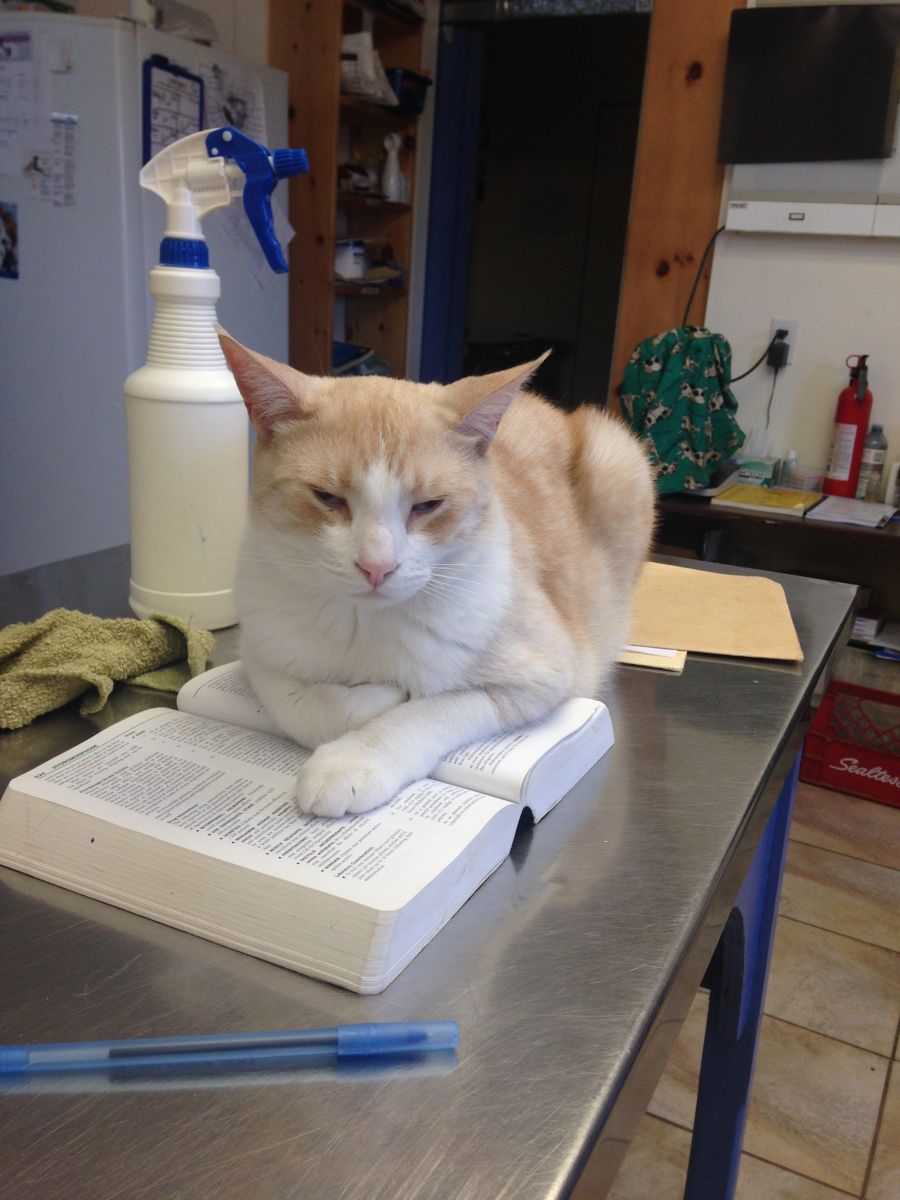Last week was a long week. Our three-day holiday weekend was filled up with dogs with heat stroke, sick horses, cows with ruptured bladders, dogs with quills, cats with urinary stones, the list goes on and on. Since then we’ve been playing catch up trying to deal with our regular appointments as well as save all of the emergencies that have swept in through the seemingly revolving clinic door. By this afternoon we were beat. Tired, hot and ready to go home, when suddenly our waiting room was filled by a group of six people all gathered around a tiny kitten found in a scrap yard on the North side of the Island. This in itself is not an unusual situation – strays are a part of life at a vet clinic, brought in by good Samaritans, fixed up and adopted out when the right person comes along. Or, as is the case for many clinic cats, they become part of our veterinary family and end up sticking around for years to come.
It is relatively easy, when you are this tired and worn out, to make an initial assessment of a patient’s situation and move right into the treatment routine without a second thought for other possibilities or problems. This kitten had a wound behind her right ear and it was basically second nature to start the treatment protocol for injured strays – clip and clean the wound, treat for internal and external parasites, start on antibiotics, pain medication if needed, good food, clean water and a safe place to rest and heal. But as we started clipping the hair away from this kitten’s wound, something just didn’t feel right. The way that the hair was coming off was odd, atypical, and it was as though the wound was sticking out from her head instead of being flat against the skin. Concerned, we stopped our clipping and moved on to plan B, which was soaking off the scab with gauze and warm water.
.JPG)
There, pointing up at us from behind the kitten’s ear, was a stick. One centimeter in diameter and extending out about one centimeter away from the skin, a regular looking, brown stick. The skin had scabbed over top of the free end of it which had given it the initial appearance of being a wound or an abscess. We all stared in disbelief as the kitten continued to splash in the water, purring away and hunting for treats with this stick poking straight out of her head.
A penetrating foreign body such as a stick presents quite a few complications, the most important of which is this: while the foreign body is in place, it can be putting pressure on damaged internal structures such as blood vessels and organs, essentially acting as an internal pressure bandage. When you remove the object, then the blood is free to flow again from the damaged area, causing a major emergency. In the event of a penetrating foreign body in the head, the dangers become even more severe, as the brain, facial nerves, inner ear structures and spinal cord lie in such close proximity. The best thing to do, if your patient is stable, is to use any form of diagnostic imaging (x-rays, ultrasound, MRI or CT) to determine what tissues and organs are affected by the foreign body and what level of damage will be caused by removing it.
Just as we were standing around the table, discussing these options for our little kitten, she gave an almighty shake of her head and dislodged the stick, sending it flying spectacularly through the air to land with a bang on the exam room table. We all immediately descended upon the kitten prepared for bleeding, trauma, emergency interventions and brain damage, but the kitten just looked up at us with a little “meow” and started purring again, apparently unharmed.
The two inch stick is now sitting in a specimen jar on our front counter as an example of just how tough our newest kitten truly is. Since her head is only about three inches across, if that stick had been aimed in any other spot on her head, it would have been a sad end for this little girl. As it is, she is now happily eating kibble and receiving snuggles after being heavily doused with antibiotics and pain medication. We have renamed her Twiggy and we are hopeful that she will come out of this whole incident with nothing more than a cool scar. She’s not out of the woods yet (pun intended), but she’s definitely a fighter and we are going to give her the best chance she can get.

Minawaa giga-waabamin, until next week.
Carson, the clinic cat, came to us as a stray after being found with a fishhook through his tongue. He and his forked tongue now rule the roost here at Scott Veterinary.
